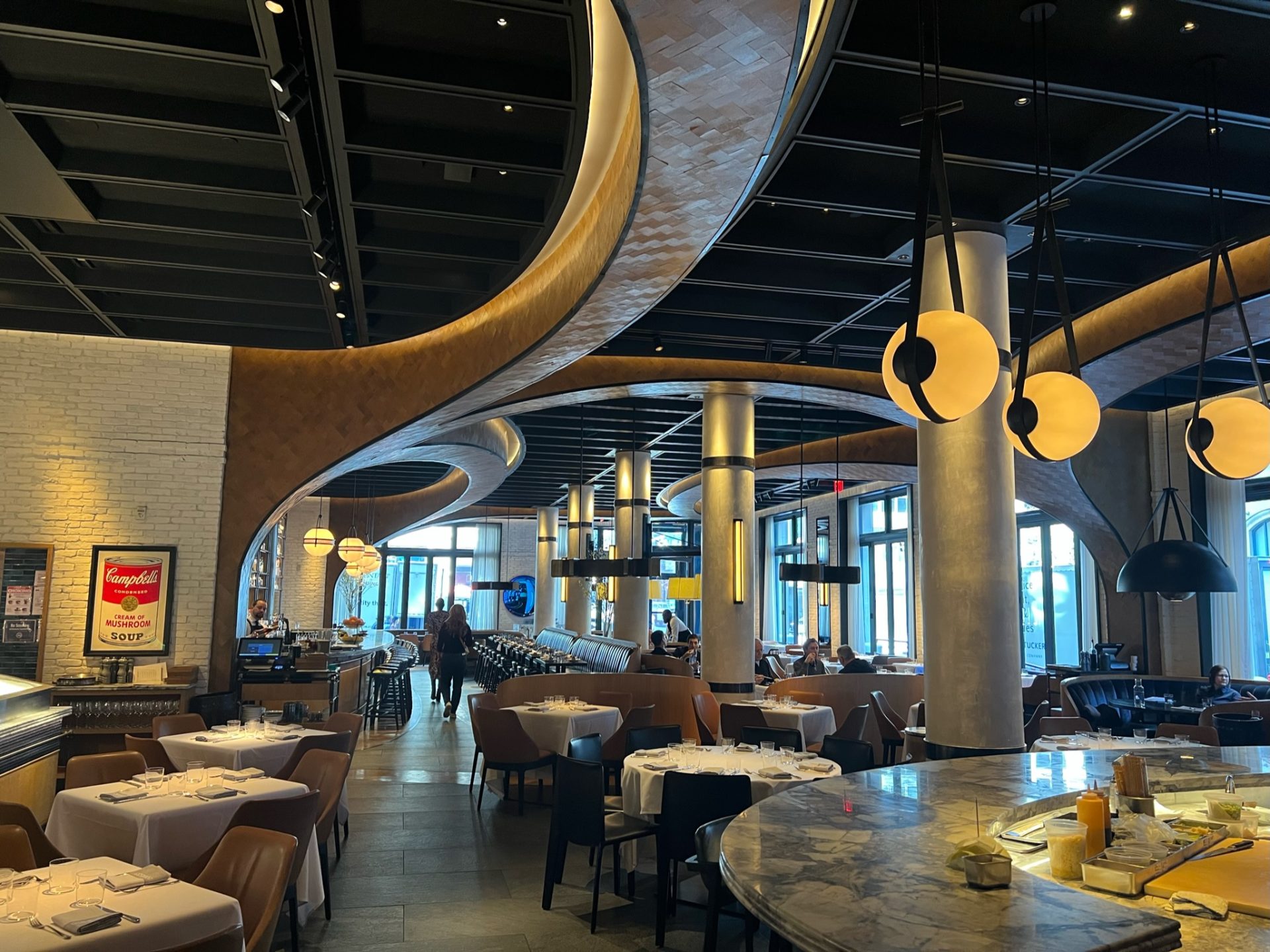Instagrammable Restaurants Islamabad: Picture-Perfect Dining Knowledge
Instagrammable Restaurants Islamabad: Picture-Perfect Dining Knowledge
Blog Article
Savor Authentic Asian Food With a Pan-Asian Twist for a Cooking Adventure
Getting started on a cooking journey via authentic Oriental cuisine, enhanced with a Pan-Asian spin, uses a special possibility to check out the abundant tapestry of tastes that specify the area's varied culinary practices. As you contemplate these enticing recipes, think about the cultural narratives and historic influences that form them, each bite using a story waiting to be found. pan asian restaurant Islamabad.

Checking Out Pan-Asian Flavors
In the world of worldwide gastronomy, Pan-Asian food sticks out for its remarkable variety and the harmonious interaction of flavors from different Oriental societies. This culinary approach celebrates the one-of-a-kind ingredients and abundant traditions discovered across the continent, developing a tapestry of preferences that is both appealing and satisfying. Secret to Pan-Asian food is its ability to balance contrasting flavors-- sweet, salty, spicy, and sour-- while highlighting the quality and quality of each active ingredient.
From the umami-rich soy sauce of Japan to the intense chili peppers of Thailand, Pan-Asian cuisine offers an extensive palette of tastes. These aspects are frequently combined in innovative ways, enhancing recipes with layers of complexity. For example, making use of fragrant natural herbs such as lemongrass and cilantro, typical in Vietnamese and Thai cuisine, includes a rejuvenating illumination to meals, while the consolidation of coconut milk provides a luscious, abundant texture.
The emphasis on fresh fruit and vegetables and aromatic spices guarantees that each dish is not only a banquet for the taste buds but likewise for the senses. Pan-Asian cuisine welcomes restaurants to embark on a cooking trip, exploring the substantial and varied landscapes of Eastern gastronomy with every bite.
Blend Meals to Try
While Pan-Asian food is commemorated for its standard flavors, the modern cooking landscape is progressively accepting blend dishes that blend these traditional elements with influences from various other areas. This ingenious approach not only honors the rich heritage of Oriental culinary arts yet additionally introduces unique preference experiences that attract modern palates.
A prime instance of such a fusion recipe is the Korean-Mexican taco, where marinaded bulgogi beef is wrapped in a cozy tortilla, topped with kimchi and a hot gochujang-infused salsa. This mix marries the strong, tasty flavors of Korea with the vibrant, fresh components of Mexican food. Likewise, sushi burritos have acquired popularity, amalgamating the delicate virtuosity of Japanese sushi with the passionate, hand-held ease of a burrito, typically featuring combination components like tempura shrimp and avocado with a drizzle of wasabi mayo.
Another significant dish is Thai curry ramen, which instills the luscious, fragrant flavors of Thai curry into the reassuring broth of traditional Japanese ramen, creating a harmonious mix that entices the senses. These fusion dishes extend past plain uniqueness; they represent a culinary dialogue between cultures, encouraging expedition and advancement in the globe of Pan-Asian cuisine.
Necessary Active Ingredients and Seasonings
To truly appreciate Pan-Asian food, one must comprehend the crucial ingredients and spices that develop its foundation. This diverse culinary style draws from an abundant tapestry of Oriental customs, employing an unified blend of flavors and structures.
Fragrant elements are essential, with garlic, ginger, and lemongrass being common across different Pan-Asian recipes. These active ingredients offer an aromatic base that boosts the intricacy of tastes. Spices such as star anise, cardamom, and cinnamon introduce warmth and personality, resembling impacts from areas like China and India.

Food Preparation Strategies and Tips
Mastering the art of Pan-Asian cuisine calls for knowledge with its distinct food preparation strategies, each adding to the vivid tapestry of flavors this culinary practice is commemorated for. Central to these approaches is the stir-fry, a fast cooking technique that preserves the nutritional stability and dazzling colors of components. Utilizing a frying pan, the stir-fry approach enables also warm circulation, necessary for attaining the particular texture and taste equilibrium of Pan-Asian recipes.
An additional basic technique is steaming, especially prevalent in Chinese cuisine. This mild approach maintains the all-natural tastes and nutrients of ingredients, making it ideal for seafood and vegetables. Dumplings, a cherished staple, typically take advantage of steaming, causing soft, delicious structures.
Grilling, also indispensable, gives great smoky depths to dishes such as Oriental bulgogi or Japanese yakitori (Fine dining experience Islamabad). This method often involves seasoning components, enabling flavors to pass through deeply prior to cooking over an open fire or warmer
Finally, understanding the art of stabilizing flavors-- sweet, sour, salty, bitter, and umami-- is vital. Effectively layering these aspects can elevate a dish from ordinary to extraordinary, supplying a complicated and satisfying cooking experience that personifies the essence of Pan-Asian food.
Dining Experiences Worldwide
Around the world, Pan-Asian cuisine provides an exceptional eating experience, commemorated for its rich tapestry of flavors and vivid discussions. This cooking sensation has actually gone beyond social borders, recording the hearts and tastes buds of food enthusiasts worldwide. In worldwide cities like New York, London, and Sydney, Pan-Asian dining establishments function as melting pots where cooking customs from Thailand, Japan, China, and past assemble, offering diners with a diverse mix of dishes that highlight the area's variety.
The international appeal of Pan-Asian cuisine lies in its capacity to supply both authenticity and advancement. Cooks skillfully wed standard ingredients such as lemongrass, soy sauce, and miso with modern strategies, leading to dishes that are both refreshingly new and familiar. This blend enables restaurants to start a cooking journey that values heritage while embracing modernity.
Additionally, dining experiences are raised through attentively made atmospheres that reflect the principles of Pan-Asian appearances. From minimal Japanese-inspired interiors to lively Thai-themed spaces, each restaurant offers an unique atmosphere that matches the cooking offerings. Because of this, clients are not merely taking in a dish however partaking in a cultural experience, making Pan-Asian eating best asian restaurant Islamabad a truly worldwide phenomenon.
Final Thought
The expedition of Pan-Asian cuisine provides an extensive understanding of the detailed interplay of flavors and cooking practices across Asia. By accepting combination meals such as Thai curry ramen and sushi burritos, the culinary trip not just highlights the adaptability of conventional active ingredients but additionally showcases innovative contemporary methods. This gastronomic experience, enriched by important seasonings and cooking methods, gives a distinct possibility to appreciate the multiculturalism and culinary creativity that specify Pan-Asian food on a global scale.
Embarking on a culinary trip via authentic Eastern food, improved with a Pan-Asian twist, provides a distinct possibility to explore the rich tapestry of tastes that specify the area's diverse cooking traditions.In the realm of global gastronomy, Pan-Asian cuisine stands out for its exceptional diversity and the harmonious interplay of flavors from different Oriental societies. Trick to Pan-Asian cuisine is its capacity to stabilize contrasting tastes-- sweet, salty, spicy, and sour-- while highlighting the quality and top quality of each ingredient.

Report this page